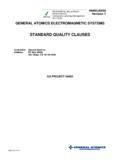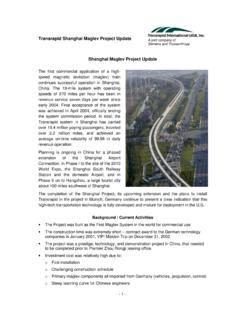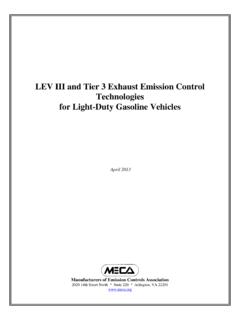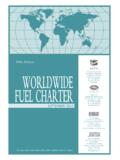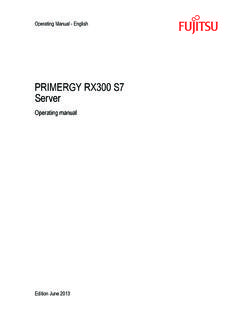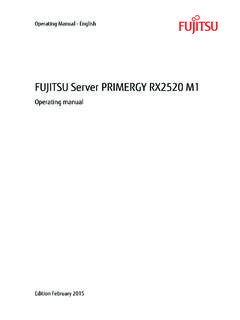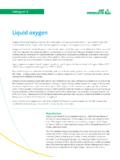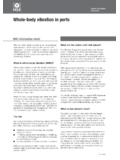Transcription of Railroad and Locomotive Technology Roadmap - General …
1 ANL/ESD/02-6 Railroad and Locomotive Technology RoadmapCenter for Transportation ResearchArgonne National LaboratoryOperated by The University of Chicago,under Contract W-31-109-Eng-38, for theUnited States Department of EnergyDISCLAIMERThis report was prepared as an account of work sponsored by an agency ofthe United States Government. Neither the United States Government norany agency thereof, nor The University of Chicago, nor any of theiremployees or officers, makes any warranty, express or implied, or assumesany legal liability or responsibility for the accuracy, completeness, orusefulness of any information, apparatus, product, or process disclosed, orrepresents that its use would not infringe privately owned rights. Referenceherein to any specific commercial product, process, or service by tradename, trademark, manufacturer, or otherwise does not necessarily constituteor imply its endorsement, recommendation, or favoring by the United StatesGovernment or any agency thereof.
2 The views and opinions of documentauthors expressed herein do not necessarily state or reflect those of theUnited States Government or any agency thereof, Argonne NationalLaboratory, or The University of National Laboratory, with facilities in the states of Illinois and Idaho, isowned by the United States Government and operated by The Universityof Chicago under the provisions of a contract with the Department of electronicallyat for a processing fee to Department ofEnergy and its contractors, in paper, Department of EnergyOffice of Scientific and Technical Box 62 Oak Ridge, TN 37831-0062phone: (865) 576-8401fax: (865) 576-5728email: and Locomotive Technology Roadmapby Frank Stodolsky, Roadmap Coordinator Center for Transportation Research, Energy Systems DivisionArgonne National Laboratory, 9700 South Cass Avenue, Argonne, Illinois 60439 December 2002 Work sponsored by the United States Department of Energy,Assistant Secretary for Energy Efficiency and Renewable Energy,Office of FreedomCAR and Vehicle Technologies This report is the collective effort of a team of researchers from industry, government, and Department of Energy s national laboratories.
3 Contributors are listed in the acknowledgmentssection and in the technical report is a product of Argonne s Energy Systems information on the division's scientific and engineering activities,contact:Director, Energy Systems DivisionArgonne National LaboratoryArgonne, Illinois 60439-4815 Telephone (630) 252-3724 Publishing support services were provided by Argonne s Informationand Publishing Division (for more information, see IPD s home page: ).This report is printed on recycled AvailabilityThis report is available via the Department of Energy web site, available via the Argonne National Laboratory Transportation Technology R&D Center website, , and via the DOE Information Bridge, information:Frank StodolskyRoadmap CoordinatorArgonne National Laboratory955 L Enfant Plaza North, 6000 Washington, 20024 Phone: (202) 488-2431 Email: ..11 Freight Transportation and the Railroads and National Railroad Energy Use .. Emissions Regulations.
4 113 APPROACHES .. Unique Aspects of System Analysis ..144 OPPORTUNITIES FOR ENERGY SAVINGS IN LOCOMOTIVEDIESEL ENGINES .. Fuel Injection/Combustion and In-Cylinder Aftertreatment .. Exhaust Gas Sensors and Controls ..195 OPPORTUNITIES FOR ENERGY SAVINGS IN Locomotive SYSTEMS .. Idle Reduction .. Energy Recovery .. Motors and Drives ..256 OPPORTUNITIES FOR ENERGY SAVINGS IN TRAIN SYSTEMS .. Operations Optimization .. Consist Management .. Train Fleet Management .. Wheel/Rail Friction .. Rolling FOR ENERGY SAVINGS WITH ADVANCEDPOWER PLANTS AND FUELS .. Homogeneous-Charge Compression Ignition .. Fuel Cells .. Gas Turbines .. Locomotive Alternative Fuels ..458 PROJECTED RESOURCE REQUIREMENTS ..499 Contributors to the Draft Railroad and Locomotive Technology Roadmap ..A-1 FIGURES1 Share of Total Ton-Miles of Travel by Mode, 1965 in Gross Domestic Product and Total Ton-Miles of Travel by All Modes, 1965 2001.
5 83 Rail Energy Efficiency and TMT, 1965 2001 ..104 Diesel Fuel Consumed by Class 1 Railroads, 1965 2001 ..105 EPA Locomotive Emission Fuel-Efficiency Penalties of Various Emission-Reduction Approaches ..127 Typical Train Resistance Losses for 5,800-ton Train on (a) Curved and (b) Tangent Track ..328 Comparison of Efficiencies of Diesel and Gas-Turbine Engines .. Potential Research Railroad and Locomotive Technology Roadmap is the combined effort of manydedicated people from the Railroad industry, Locomotive manufacturers and their suppliers,government, and the Department of Energy s national laboratories. We thank the reportcoordinators who were instrumental in gathering input from their teams to generate the earlierversions of this Roadmap : Robert Grimalia, Union Pacific Railroad , and Jay Keller, SandiaNational Laboratories ( Locomotive engine technologies); Brian Concannon, Argonne NationalLaboratory, and Mark Stehly, BNSF Railway ( Locomotive systems); John Punwani, FederalRailway Administration, and Greg Martin, CSX Transportation (train systems); Chuck Horton,Electro-Motive Division of GM, and Charles Roehm, Argonne National Laboratory (advancedpowerplants and fuels); and Kumar, GE Transportation Systems, and Phil Sklad, Oak RidgeNational Laboratory (materials).
6 Special thanks to Frank Stodolsky, Argonne NationalLaboratory, who coordinated the development of this Roadmap , and to Ray Fessler, Biztek, Inc.,who incorporated subsequent greatly appreciate the guidance provided by former and current members of theroadmap Steering Committee. They are Mike Rush, Association of American Railroads;Randy Wyatt, GE Corporate R&D; Chuck Horton, Electro-Motive Division of GM;Keith Hawthorne and Brian Smith, Transportation Technology Center, Inc.; Adam Oser,GE Transportation Systems; Steve Ditmeyer, Federal Railroad Administration; and James , Richard Wares, and Susan Rogers, Department of appreciate the vision and leadership of the director of the former Office of HeavyVehicle Technologies in the Department of Energy, Dr. James J. Eberhardt. Without hissupport and guidance, this document would not be thank Argonne National Laboratory staff for their critical assistance on thisdocument: Linda Gaines, for her critical inputs to the Roadmap process, from organizing theinitial workshop in January 2001, to working on the final revisions of this document this pastfall; Anant Vyas, Chris Saricks, and Marianne Mintz, for their contribution to the introductoryand background sections; Steve Ciatti, for his constructive comments on the technical content;Terry Levinson, for assisting with the workshop and the production of this document; Kevin and Catherine Kaicher, for editing and coordinating document production under severetime constraints; and Kerri Schroeder, for document processing.
7 Also, we thank Betty Watermanand Renee Nault for setting up and maintaining the Roadmap temporary web site, which provedto be a vital means of transmitting information among the SinghDr. Sidney DiamondTeam LeaderTechnology Development SpecialistEngine and Emission-Control TechnologiesHeavy Vehicle Systems Technologies andHeavy Vehicle MaterialsOffice of FreedomCAR and VehicleTechnologiesOffice of FreedomCAR and VehicleTechnologiesDecember 2002viii1 SUMMARYR ailroads are important to the economy. They transport freight efficiently becausethey require less energy and emit fewer pollutants than other modes of surface the fuel efficiency of the Railroad industry has improved steadily by 16% over thelast decade more can, and needs to, be done. Fuel efficiency has recently become even morecritical with the introduction of strict emission standards by the Environmental approximately 4 billion gallons of diesel fuel that are used by locomotives each yearis about 10% of the total diesel fuel used in transportation and of all the fuel used intransportation in the United States (Davis 1997).
8 Large freight carriers consume most of this railroads spend over $2 billion per year, or approximately 7% of their total operatingexpenses, on diesel fuel (AAR 2002).1 Because fuel costs represent a significant portion of thetotal operating costs of a Railroad , fuel efficiency has always been an important factor in thedesign of locomotives and in the operations of a Railroad . In terms of energy efficiency, these aredollars well spent. An important measure of rail energy efficiency is revenue ton-miles pergallon of fuel consumed. A revenue ton-mile is one ton of a customer s goods moved one stated, it measures the amount of real work that freight railroads do for their customersfor every gallon of fuel used. (Passenger railroads use passenger-miles per gallon for a similarmeasure.) America s railroads have dramatically increased the number of ton-miles delivered pergallon from 235 in 1980, to 332 in 1990, and then to 403 in 2001, which is an increase of over71% (AAR 2002).
9 This achievement was due to the combined effect of many technologicaladvances and improvements in dispatching and operations, as well as to shifts in the mix ofcommodities transported and to longer shipment distances by dense commodities, like Environmental Protection Agency has established strict emission standards tobe implemented in stages (Tiers 0, 1, and 2) between 2000 and 2005. Locomotives currently emitover one million tons of NOx each year, which is about 5% of total NOx emitted by all sources(Orehowsky 2001). Some of the technologies that could be employed to meet the emissionstandards may negatively affect fuel economy by as much as 10 15% when emissions arereduced to Tier 2 levels. Lowering fuel economy by that magnitude would have a serious impacton the cost to the consumer of goods shipped by rail, on the competitiveness of the railroadindustry, and on this country s dependence on foreign ability of Locomotive manufacturers to conduct research into fuel efficiency andemissions reduction is limited by the small number of locomotives manufactured annually.
10 Eachyear for the last five years, the two North American Locomotive manufacturers GeneralElectric Transportation Systems and the Electro-Motive Division of General Motors havetogether sold about 800 locomotives in the United States. With such a small number of units over 1 The fuel share is computed as the ratio of total diesel fuel expenses to total expenses and taxes ( , excluding netoperating income) for Class I railroads, as reported in AAR s Railroad Facts (AAR 2001). 2An estimated 43% of the gain came from the increased share of ton-miles represented by coal and other densecommodities (Vyas 2001).2which research costs can be spread, outside help is needed to investigate all possible ways toreduce fuel usage and the importance of fuel costs and emissions compliance to the railroadindustry, the Department of Energy (DOE) convened a workshop in January 2001(ANL 2001) to (1) determine the interest of the Locomotive and Railroad industries in crafting ashared vision of Locomotive and Railroad Technology of the future and (2) identify criticalresearch and development (R&D) needs for reducing fuel consumption and emissions whilemaintaining or enhancing system a result, the railroads, their suppliers, and the federal government have embarked on acooperative effort to further improve Railroad fuel efficiency by 25% between now and 2010and by 50% by 2020, on an equivalent gallon per revenue ton-mile basis.
